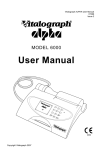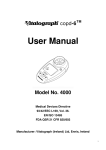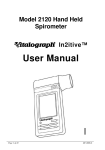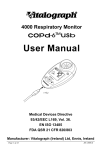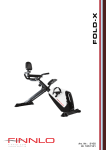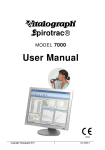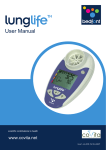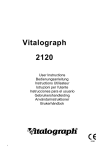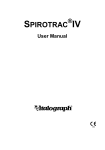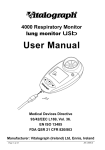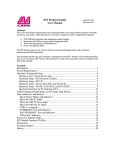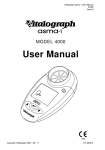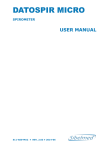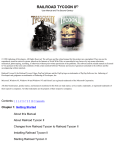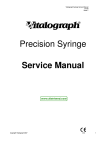Download User Manual
Transcript
Vitalograph Compact User Manual 07330 Issue 1 Vitalograph COMPACT MODEL 6600 User Manual l Copyright Vitalograph 2004 Vitalograph Compact User Manual 07330 Issue 1 Vitalograph Ltd., Maids Moreton, Buckingham, MK18 1SW, England Phone: (01280) 827110 Fax: (01280) 823302 e-mail: [email protected] Vitalograph GmbH, Jacobsenweg 12, 22525 Hamburg, Germany Phone: (040) 54 73 91-0 Fax: (040) 547 391 40 e-mail: [email protected] Vitalograph Inc., 8347 Quivira Road, Lenexa, Kansas 66215, U.S.A. Phone: (913) 888-4221 Fax: (913) 888-4259 e-mail: [email protected] Vitalograph (Irl.) Ltd., Gort Road Business Park, Ennis, Co. Clare, Ireland Phone: (065) 6864100 Fax: (065) 6829289 e-mail: [email protected] Internet: www.vitalograph.com © Copyright Vitalograph 2004 Current Edition (Issue 1) Cat. No. 07330 Vitalograph is a registered trademark Copyright Vitalograph 2004 Table of Contents DESCRIPTION OF THE VITALOGRAPH COMPACT 1 MAIN COMPONENTS OF THE VITALOGRAPH COMPACT 1 FEATURES OF THE VITALOGRAPH COMPACT 1 GETTING THE VITALOGRAPH COMPACT READY FOR USE 2 OPERATING THE VITALOGRAPH COMPACT 2 LOGGING IN ENTERING OR SELECTING SUBJECT INFORMATION CREATING A NEW SUBJECT Creating a New Subject for a Non-advanced User Creating a New Subject for an Advanced User. SELECTING A SUBJECT FROM THE DATABASE PERFORMING A TEST SESSION Checks to Make before Performing a Test Session Performing an FVC Test Performing a Single Breath Test Continued Using the Incentive Device PERFORMING CLOSED CIRCUIT SPIROMETRY PERFORMING A POST TEST SESSION PRINTING AND VIEWING TEST SESSIONS Printing a Test Session Viewing a Test Session MODIFYING SUBJECT INFORMATION Modifying Subject Information for a Non-advanced user Modifying Subject Information for an Advanced User. CHECKING ACCURACY VIEWING/PRINTING THE ACCURACY LOG WHEN TO CHECK ACCURACY 2 3 3 4 6 7 8 8 8 11 12 15 18 19 20 20 21 21 24 25 26 27 DELETING SUBJECT INFORMATION AND/OR TEST RESULTS. 27 POPULATION GROUPS AND NORMAL SETS 29 TEST CONFIGURATION 31 VITALOGRAPH COMPACT CONFIGURATION 36 i REPORT/PRINTER OPTIONS 40 FITTING A NEW PAPER ROLL 42 USER CONFIGURATIONS 43 CLEANING INSTRUCTIONS 44 CLEANING AND DISINFECTING THE VITALOGRAPH COMPACT DISASSEMBLING THE VITALOGRAPH COMPACT REASSEMBLING THE FLEISCH FLOWHEAD 44 47 48 FAULT FINDING GUIDE 49 CUSTOMER SERVICE 51 CONSUMABLES AND ACCESSORIES 51 EXPLANATION OF SYMBOLS 52 OTHER LABELS 52 TECHNICAL SPECIFICATIONS 53 CE NOTICE 53 FDA NOTICE 53 DECLARATION OF CONFORMITY 54 GUARANTEE 55 BUTTONS AND ICONS USED IN COMPACT 56 ii Vitalograph Compact User Manual 07330 Issue 1 D C Copyright Vitalograph 2004 A B DESCRIPTION OF THE VITALOGRAPH COMPACT The Vitalograph COMPACT is a desktop spirometer designed for use by trained professionals in the doctor’s office, clinic, hospital department, clinical trials, etc. for measuring and archiving tests on human subjects. Demographic data are uploaded or entered via a touchscreen and stored, together with spirometry test data. Current test data and the subject’s history can be viewed on the LCD and printed and downloaded to a PC. There are a variety of backup and other configuration options. Information about the software can be obtained from the About box. This information can be used if any queries are made to Vitalograph or a service agent. To access the About box: 1. Press the More button on the Home screen. 2. Press the About button. MAIN COMPONENTS OF THE VITALOGRAPH COMPACT A B C D Vitalograph COMPACT device LCD/Touchscreen Flowhead Printer FEATURES OF THE VITALOGRAPH COMPACT The Vitalograph COMPACT’s features include: • • • • • • 1 Very high accuracy, linearity and stability Automatic trending Extremely simple to operate touchscreen with extra-large buttons Integral printer for instant results or optional external printing Automatic storage of tests and demographic information Ability to exchange information with a PC • • Robust, proven fleisch-type flowhead. No moving parts or delicate sensors Simple cleaning. The flowhead completely dismantles for washing, disinfecting or even autoclaving. GETTING THE VITALOGRAPH COMPACT READY FOR USE 1. Attach the flowhead to the Vitalograph COMPACT by the dual silicone tubing (Flowhead Connection Tube). Ensure that the coloured/ribbed tapping on the flowhead is connected to the ribbed side of the connection in the housing. 2. Open the printer door and remove bubble wrap from each side of paper roll. 3. Only use the Vitalograph COMPACT with the purpose-built low voltage power supply unit with which it is supplied. Attempted use with other power sources may cause irreparable damage and invalidate the warranty. The output from the power supply is 10 volts DC. 4. Connect the jackplug from the power supply into the socket on the rear of the Vitalograph COMPACT. The IEC connector on the mains lead plugs into the socket on the power supply. Plug the mains plug into a suitable socket, operate the On/Off switch on the rear of the instrument and the Vitalograph COMPACT is ready for use. 5. A helpful demonstration will automatically start when the COMPACT is powered up for the first time. On subsequent powerup the demonstration will not start automatically. To access the demonstration again press the Help button on the Home screen. Note: A complete list of the buttons and icons used in this device is available at the back of this Manual. OPERATING THE VITALOGRAPH COMPACT Logging In The COMPACT can be configured so that a user must login during power-up. (See section User Configurations). If this option is selected, 2 the user is presented on power-up with a login screen showing a list of users stored in the database. There are two options available: 1. Select the required username from the list-box and continue to login by pressing the Return button. 2. If the required username is not on the list, then you can create one by pressing the New User button. Enter the username using the on-screen keyboard. When you have entered the username you can do one of two things: a. Save the username to the database and return to the login screen by pressing either the Home or Return buttons. b. Do not save the changes and return to the login screen, by pressing the Back button. or Entering or Selecting Subject Information In order to save test sessions to the database, a current subject must first be created or selected for test. You can: • Enter subject information for a new subject as described in the Creating a New Subject section. This information is stored on the database. Or • Recall a previously entered subject from the database as described in the Selecting a Subject from the Database section. Creating a New Subject There are 2 methods available to the user for creating a New Subject: • Creating a new subject for a non-advanced user. • Creating a new subject for an advanced user. 3 Note: Refer to section User Configurations for instructions on how to set a user to advanced and non-advanced. To access the New Subject screen, select the New Subject button from the Home screen. Creating a New Subject for a Non-advanced User After entering the New Subject screen, you are presented with a series of dialog boxes in which you can enter information. Once you are ready to move onto the next dialog box, press the Enter key on the keyboard. These dialog boxes appear one at a time in the following order: 1. Enter Last Name using the on-screen keyboard (Last Name) 2. Enter First Name using the on-screen keyboard 3. Enter Date of Birth using the on-screen keyboard 4. Enter Male/Female by selecting the relevant option (First Name) (Date of Birth) / (Male/Female) 5. Enter Height using the on-screen keyboard (Height) Note: The next dialog box will appear automatically if the maximum information allowed for a field has been entered. When the subject’s height has been entered, a dialog box containing the subject ID will appear at the top of the screen. This ID is created by the COMPACT unit, but it can be modified by the user if required. There are four options available to you at this stage. You can: 1. Save the new subject to the database and return to the Home screen by pressing the Home button. 4 2. Return to the Home screen without saving the new subject to the database by pressing the Back button. 3. Save the new subject to the database and perform a test session by pressing either the Enter key on the LCD keyboard or the Return button. 4. Enter additional subject information by pressing the Forward button. This option will allow you to enter: a. Population group from a drop down list b. Weight using the on-screen keyboard 5. There are now two options available: a. Return to the New Subject screen by pressing the Back button. b. To modify the smoking information, press the Forward button. This will allow you to modify the smoking status by selecting the relevant option from the following: i. Non-smoker ii. Current smoker iii. Ex-smoker For a Current smoker, you will need to enter the: i. Cigs. per day ii. Year started For an Ex-smoker, you will need to enter the: i. Cig. per day ii. Year started iii. Year quit c. If you suspect the subject has COPD, check the COPD check box. d. Enter subject comments in the field provided using 5 the on-screen keyboard 6. You can return to the New Subject screen by pressing the Back button twice. (X2) Creating a New Subject for an Advanced User. After entering the New Subject screen, you are presented with a series of dialog boxes. 1. Enter data in the fields as required. a. Enter the subject ID using the on-screen keyboard b. Enter last name using the on-screen keyboard c. Enter first name using the on-screen keyboard d. Enter the population group from a drop down list e. Enter date of birth using keyboard f. the (Subject ID) (Last Name) (First Name) (Population Group) on-screen Enter gender by selecting the relevant option (Date of Birth) / (Male/Female) g. Enter height using the on-screen keyboard Height h. Enter weight using the on-screen keyboard Weight 2. Once you are ready to move onto the next field press Enter on the keyboard. Note: The curser will move on automatically if the maximum information allowed for a field has been entered. Any or all fields can be left blank also. 3. When you are satisfied with the data you have entered, you can do one of four things: 6 a. Save the new subject to the database and return to the Home screen by pressing the Home button. b. Return to the Home screen without saving the new subject to the database by pressing the Back button. c. Save the new subject to the database and perform a test session by pressing the Return button. Note: The unit will only allow you to perform a test if a subject ID has been created. If you did not enter a subject ID, the unit will automatically create one. You can modify this if required. c. Enter the smoking information screen by pressing the Forward button. Refer to section Creating a New Subject for a Non-advanced User for entering information here. Selecting a Subject from the Database If a subject has previously been created, the details will be stored in the database. Follow these steps to recall a subject from the database. 1. To access the Recall Subject screen, press the Recall Subject button on the Home screen. 2. All subjects are listed. It is possible scroll down through the list by pressing the up/down arrows on the list box. 3. You can list the subject by Name or ID by making the relevant selection. 4. Highlight the subject you require by making a selection in the list box. The subject will now appear in the dialog box beside the list box. You can now do one of three things: a. Make the selection the current subject and return to the Home screen by pressing the Home button. 7 or Note: If the selected subject has a name entered it will appear at the status bar on the bottom of the screen. If the selected subject has no name entered the text ‘No name entered’ will appear on the status bar. b. Cancel the selection and return to the Home screen by pressing the Back button. c. Make the selection the current subject and edit the subject’s information by pressing the Return button. Refer to section Modifying Subject Information on how to edit subject information. Carry out a test session on the selected subject by pressing the Return button again. Performing a Test Session Checks to Make before Performing a Test Session Before starting a test session, there are a number of checks which should be made: 1. Ensure that the accuracy of the COMPACT unit was checked recently. (Refer to section on Checking Accuracy) 2. Check that the required Save Options, FVC Test Type and Test Indices are selected. (Refer to section on Test Configuration). 3. Check that a subject is selected and that all the required demographic information is entered for the subject. (Refer to section on Selecting a Subject from the Database). Note: If a name has been entered, then that name will appear in the status bar. If no name has been entered, then ‘No name entered’ will appear on the status bar. Performing an FVC Test There are two test types that can be performed using the COMPACT. These are: • Single Breath Test • Closed Circuit Spirometry Refer to section on Test Configuration for selecting the test type. 8 Performing a Single Breath Test Follow these steps to perform a single breath test: 1. Press the Perform Test button on the Home screen. Note: If no subject has been selected from the database then you will be presented with a list of all subjects. There are two options here. You can: a. Select the subject required and press the Enter key. The subject’s demographic information will then be displayed. Review this and change if required. Press the Enter key to display the testing screen. b. Press the Enter key without selecting any subject from the database. The COMPACT unit will automatically create a subject ID before displaying the testing screen. Depending on the Test Configuration settings, you may be presented with a testing screen to either perform a VC or an IVC test. Note: If neither VC or IVC is selected in the Test Configuration settings, then the testing screen will not be displayed. Perform a VC Test 1. Wait for the Exhale to Begin icon to appear. This indicates that the COMPACT unit is ready to accept a blow. 2. Read the following instructions to the subject so that testing is performed properly: a. Stand up. b. Keep the flowhead away from your mouth. c. Inhale as deeply as possible and insert the mouthpiece into your mouth, clamping it between your teeth. d. Close your lips around the mouthpiece. e. Exhale normally for as long as possible. 9 3. If you are prompted to accept the test, press the Cancel button to reject the test or the Enter key to accept the test. The VC values recorded for the blow are tabulated. The best VC value for the current session and the Lower Limit of Normality (LLN) are also displayed. 4. Repeat to perform another VC test if required. Note: A maximum of 12 VC tests can be performed in one session. 5. After performing the VC tests, you can do one of four things: a. Return to the Home screen by pressing the Home button. This will finish the test session. b. Return to the Subject Select screen by pressing the Back button. This will end the test session. c. Perform a Single Breath Test by pressing the FVC button. d. Perform a Post test by selecting the Post button. Note: Refer to the section on Performing a Post Test Session Perform an IVC Test 1. Wait for the Exhale to Begin icon to appear. This indicates that the COMPACT unit is ready to accept a blow. 2. Read the following instructions to the subject so that testing is performed properly: a. Stand up. b. Insert the mouthpiece into your mouth and, clamping it between your teeth. c. Close your lips around the mouthpiece. d. Breathe in and out normally. This is tidal breathing. 10 When you are happy that the subject has achieved steady tidal breathing, continue with: e. Exhale as deeply as possible. f. Inhale as much as possible (speed is not important) and when fully inhaled g. Return to tidal breathing i.e.: Breathe in and out normally again. 3. If you are prompted to accept the test, press the Cancel button to reject the test or the Enter key to accept the test. The IVC values recorded for the blow are displayed in the table. The best IVC value for the current session and the Lower Limit of Normality (LLN) are also displayed. 4. Repeat to perform another IVC test if required. Note: A maximum of 12 IVC tests can be performed in one session. 5. After performing the IVC tests, you can do one of four things: 1. Return to the Home screen by pressing the Home button. This will end the test session. 2. Return to the Subject Select screen by pressing the Back button. This will end the test session. 3. Perform a single breath test by pressing the FVC button. 4. Perform a Post test by pressing the Post button. Note: Refer to the section on Performing a Post Test Session Performing a Single Breath Test Continued Note: If you have not selected either of the VC or IVC check boxes in the Test Indices selection screen, you will be brought directly into the FVC test screen. 11 1. Press the FVC button in the VC or IVC screens to enter the Single Breath Test screen. To perform a Single Breath Test: a. Wait for the Exhale to Begin icon to appear. This indicates that the COMPACT unit is ready to accept a blow. b. Read the following instructions to the subject so that testing is performed properly: i. Stand up. ii. Keep the flowhead away from your mouth. iii. Inhale as deeply as possible and inset the mouthpiece into your mouth, clamping it between your teeth. iv. Close your lips around the mouthpiece. v. Exhale as much and as quickly as possible and try to keep exhaling for at least 6 seconds. vi. If inspiratory indices are selected, then inhale as quickly as possible. 2. If you are prompted to accept the test, press the Cancel button to reject the test or the Enter key to accept the test. The FVC and FEV1 values recorded for the blow are tabulated. The best FVC and FEV1 values for the current session and the Lower Limit of Normality (LLN) are also displayed. 3. Repeat to perform another Single Breath Test if required. Note: A maximum of 12 Single Breath tests can be performed in one session. Using the Incentive Device The Incentive Device is used as an aid in the Single Breath Test of children. To access this: 1. Press the Incentive button on the top of the screen. Note: You must wait for the Exhale to Begin icon to appear before a blow can be performed. 12 2. To view the results for the individual blows associated with the test session, press the Results tab. The blows are listed in order of ranking. The best blow being listed first. Predicted values are selected for the selected indices. The predicted number will be displayed if the date of birth, height, gender and population group are entered. 3. To view the next ranked blow, press the Arrow button. 4. To view the trend graph for the current subject, press the Trend tab. There is an option here to switch between trending. Trending for all test sessions performed will be shown by default when you select the Trend tab. This is a seventy-year trend of the best FEV1 value. A predicted line is shown from the 25–70th year, if the subject’s demographic information is entered. a. In order to view the trend of the last ten test sessions, press the Ten Point Trend button. b. To switch back to the full trend, press the Full Trend button. 5. Press the Info tab to view the quality information and the interpretation of the session results. The reproducibility information for FVC, FEV1 and PEF is displayed if at least two tests are performed. If the reproducibility criteria are met, then a message saying ‘GOOD test session’ is displayed. No reproducibility information will be displayed if the manual save option is selected. Refer to the Test Configuration section. 13 1. Press the Interpretation button to view the suggested interpretation of the results. Interpretation will be displayed if the height, date of birth and population group are entered for the subject. There also needs to be a measured value of FEV1. 2. Press the COPD Risk button to view the COPD risk. This calculates a subject’s risk of developing COPD within the next 10 years, and also the risk if the subject stopped smoking. COPD risk will be displayed if the date of birth, gender and current smoking information has been entered. There also needs to be a measured value of FEV1. 3. Press the COPD Number button to view the COPD score. The COPD number is the measured FEV1 as a percent of the value compared with a reference population of people without lung disease. This is used as a method of categorising the severity of airway obstruction in subjects with COPD. Most lung damage is permanent, so the initial COPD number is unlikely to improve. However, if it remains close to constant, it is a positive sign that the subject’s lungs are not suffering further deterioration. The number will be displayed if the date of birth, height and population group have been entered and the COPD check box has been selected for the subject. 4. To print the COPD number, press the Print COPD button. 5. In order to view the predicted lung age, press the Lung Age button. 6. After performing the Single Breath Tests, you can do one of four things: 14 a. Return to the Home screen by pressing the Home button. This will end the test session. b. Return to the Subject Select screen by pressing the Back button. This will end the test session. c. Print the test session by pressing the Print button. This will end the test session. d. Perform a Post test by pressing the Post button. Note: Refer to the section on Performing a Post Test Session Performing Closed Circuit Spirometry Follow these steps to perform Closed Circuit Spirometry: 1. Press the Perform Test button on the Home screen. Note: If no subject has been selected from the database, then you will be presented with a list of all subjects. There are two options here. You can: a. Select the subject required. Press the Enter key and the subject’s demographic information will be displayed. Review this and change if required. Press the Enter key to bring you onto the testing screen. b. Press the Enter key without selecting any subject from the database. The COMPACT unit will automatically create a subject ID and bring you onto the testing screen. 2. If FRC, RV and TLC are selected as indices (refer to the section Test Configuration), then a screen asking you to enter a value for FRC, RV or TLC will appear. Enter a value using the on-screen keyboard. If one value is 15 known, the others may be calculated from the closed circuit test. Note: If none of the indices FRC, RV or TLC is selected in the Test Configuration screen, then this screen will not appear and you will be brought directly into the Closed Circuit Test screen. 3. Once you have the required value entered, you can do one of three things: a. Return to the Home screen by pressing the Home button. This will finish the test session. b. Return to the Subject Select screen by pressing the Back button. This will finish the test session. c. Perform a Closed Circuit Test by pressing the Return button. 4. After pressing the Enter key in FRC/RV/TLC value entry screen, you will be brought into the Closed Circuit Test screen. 5. Wait for the Exhale to Begin icon to appear. This indicates that the COMPACT unit is ready to accept a blow. Read the following instructions to the subject to ensure that testing is performed properly: a. Clip on the nose clip to seal your nose. b. Put the Bacterial Viral Filter into your mouth, biting it lightly. c. Seal your lips around the mouthpiece d. Breathe in and out normally. This is called tidal breathing. When you are happy that the subject has achieved steady tidal breathing, continue with: e. Inhale as deeply as possible f. Exhale as much and as quickly as possible, and when fully exhaled 16 g. Inhale fully as quickly as possible e. Return to tidal breathing, i.e. breathe in and out normally again. 6. If you are prompted to accept the test, press the Cancel button to reject the test or the Enter key to accept the test. The FVC and FEV1 values recorded for the Closed Circuit Test, are tabulated. The best FVC and FEV1 values for the current session and the Lower Limit of Normality (LLN) are also displayed. 7. Repeat to perform another Closed Circuit Test if required. Note: A maximum of 12 Closed Circuit Tests can be performed in one session. 8. While performing the test, you can view the flow data in Volume/Time or Flow/Volume format. To switch between the different formats: a. Select the relevant tab Volume/Time Flow/Time b. Press the Results tab to view the results for the individual blows associated with the test session. Refer to section on Single Breath Test for more information. c. Press the Trend tab to view the trend graph for the current subject. Refer to section on Single Breath Test for more information. d. Press the Info tab to view the quality information and the interpretation of the session results. Refer to section on Single Breath Test for more information. 9. After performing the Closed Circuit tests, you can do one of four things: a. Return to the Home screen by pressing the Home button. This will end the test session. 17 b. Return to the Subject Select screen by pressing the Back button. This will end the test session. c. Print the test session by pressing the Print button. This will end the test session. d. Perform a Post test by pressing the Post button. Note: Refer to the section on Performing a Post Test Session. Performing a Post Test Session A Post test session can be performed on an FVC test following the administration of drugs. Post drug delivery performance is measured versus pre delivery. To perform a Post test: 1. Press the More button on the Home screen. 2. Press the Post Test button. 3. If there is no current subject selected then you will be presented with the list of subjects saved to the database. Select the required subject and press the Return button. Note: If there is already a current subject selected, then you will be brought into the pre-session select screen. 4. You will be presented with a list of pre-test sessions performed by the current subject, listed by date and time. Select the pre-test from the list and press the Return button. Note: If the FVC test type was a closed circuit test, then the session will be marked CCS. 18 5. You will be brought into the test screen. Perform the Post test as normal. Refer to the sections on Performing a Single Breath Test and Performing Closed Circuit Spirometry. Note: You can also access the Post test screen from within the pretest session screen. Press the Post button on the top of the screen. This will end the current session and bring up the list of pre-test sessions performed by the current subject, with the last session highlighted. Printing and Viewing Test Sessions You can print or view test sessions for any subject. The COMPACT has an internal printer but can also be connected through the USB A port at the rear of the unit to an external USB printer. Note: The internal (thermal) printout will fade over time when exposed to light or heat. If a permanent record is required, photocopy the thermal printout or print to the external USB printer. Note: Refer to the section on Report Options for information on selecting the internal or external printer. Contact Vitalograph for a list of compatible USB printers. To access the print/preview screen, press the Print Report button on the Home screen. Note: A current subject must first be selected. Refer to the section on Selecting a Subject from the Database to do this. After entering the Session Select screen, you are presented with a log of sessions performed by the current subject. The following information is contained in the log: a. Session date b. Session time c. Pre or Post Test. Note: An ‘*’ will appear in the log if it is a Post test session 19 d. Session type. CCS will appear in the log if closed circuit spirometry was carried out by the subject. Note: Pressing the Home or Back buttons will bring you back to the Home screen. or Printing a Test Session To print a particular session, select it and press the Print button. Viewing a Test Session 1. To view a particular session, select it and press the Preview button. The selected session will be recalled from the database. 2. Review the graphs by selecting the Graphs tab. a. For a single breath FVC test, press the Graphs tab This will show the Flow/Volume and Volume/Time curves for the test session. b. For a closed circuit spirometry FVC test type, press the Graphs tab. This will show the Flow/Volume curve for the test session. Note: The Volume/Time curve cannot be viewed. 3. Review the results by selecting the Results tab. Note: Refer to the section on Performing a Test Session on the information displayed in this tab. 4. View the trend graph by selecting the Trend tab. 20 Note: Refer to the section on Performing a Test Session on the information displayed in this tab. 5. Review the quality information by selecting the Info tab. Note: Refer to the section on Performing a Test Session on the information displayed in this tab. 6. After reviewing the test session results, you can do one of four things: a. Return to the Home screen by pressing the Home button. b. Return to the Session Select screen by pressing the Back button. c. Print the test session by pressing the Print button. d. Perform a Post test by selecting the Post button. Note: Refer to the section on Performing a Post Test Session for information on performing a Post test. Modifying Subject Information It is possible to modify subject information stored on the database. Both non-advanced and advanced users can modify the subject information stored on the database. Note: Refer to the section User Configurations for more information on setting a user to being advanced and non-advanced. The subject must first be recalled from the database, as per section on Selecting a Subject from the Database. Modifying Subject Information for a Non-advanced user 21 Once the subject information is recalled from the database, you can modify the information fields as follows: 1. To change the subject’s last name, place the curser in the last name ), delete the existing text and type the new text using the field ( on-screen keyboard. You can also modify: a. First name using the on-screen keyboard (first name) b. Date of birth using the on-screen keyboard (Date of birth) c. Gender by selecting the relevant option / (Male/Female) d. Height using the on-screen keyboard (Height) Note: The Subject ID cannot be altered. (Subject ID) 2. To modify additional subject information, press the Forward button. This will allow you to modify: a. Population group from a drop-down list b. Weight using the on-screen keyboard c. Smoking information. To modify the smoking information, press the Forward button. This will allow you to modify the smoking status by selecting from the following options: i. Non-smoker ii. Current Smoker 22 iii. Ex-smoker For a Current Smoker you can modify the: i. Cigs. per keyboard day using the on-screen Year Started using the keyboard For an Ex-smoker you can modify the: on-screen ii. i. Cigs. Per day keyboard ii. Year Started keyboard iii. Year Quit using the on-screen keyboard using using the the on-screen on-screen d. You can check/uncheck the COPD check box. e. Modify subject keyboard. comments using the on-screen 3. Return to the New Subject screen by pressing the Back button twice. (x2) When you have made all the changes required, you can do one of three things: a. Save the changes to the database and return to the Home screen by pressing the Home button. b. Do not save the changes to the database and return to the Home screen by pressing the Back button. c. Save the changes to the database and perform a test session by pressing the Return button. 23 Modifying Subject Information for an Advanced User. Once the subject information is recalled from the database, you can modify the information fields as follows: 1. Change the subject’s last name by placing the curser in the last ), deleting the existing text and typing the new text name field ( using the on-screen keyboard. You can also modify: a. The first keyboard name using the on-screen (first name) b. The population group from a drop-down list (Population Group) c. The date of birth using the on-screen keyboard d. Gender by selecting the relevant option (Date of birth) / (Male/Female) e. Height using the on-screen keyboard (Height) f. Weight using the on-screen keyboard (Weight) Note: The Subject ID cannot be altered. 2. To modify the smoking information, press the Forward button. Refer to Modifying Subject Information for a Non-advanced User for modifying smoking information. 24 CHECKING ACCURACY All spirometry standards (e.g. ATS/ERS/BTS/ANZRS) recommend checking the accuracy of lung function measuring devices at least daily with a 3-L syringe to validate that the instrument is measuring accurately. The Vitalograph COMPACT should never be outside accuracy limits unless damaged or in a fault condition. In this event, see the fault-finding guide. In normal use, calibration traceability certification is recommended as a part of the routine annual service. ATS recommendations require that the difference between the volume measured by the spirometer and the volume pumped into the spirometer from a syringe is within 3%. Follow these steps to check the accuracy of the unit. 1. Attach the flowhead to the precision syringe. 2. Press the More button on the Home screen. 3. Press the Accuracy Check button. 4. Press the Accuracy Check button again. 5. Enter user I.D. 6. Enter the volume of the syringe 7. Enter the syringe serial number. 8. Pump air through the flowhead to bring it to ambient temperature. If the flowhead has very recently been used for testing or has come from a cold environment, its temperature should be equilibrated with ambient by pumping air through it from the syringe several times. 9. Press the Return button. 25 Follow the on-screen instructions. 10. If a print out is required, press the Print button. Viewing/Printing the Accuracy Log The accuracy check is added to a log. Follow these steps to view the log. 1. Press the More button on the Home screen 2. Press the Accuracy Check button. The log contains the following information: a. b. c. d. e. Date of accuracy check Time of accuracy check Syringe serial number Volume of syringe Volume recorded by COMPACT. The following *** will appear beside the log if the calibration was updated on the unit. It is possible to print the accuracy check log by pressing the Print button. In addition to the above items, the following will be shown on the printout: f. User ID g. Ambient temperature at time of accuracy check. The date and time the log was printed and the COMPACT serial number will be shown in the headings. 26 When to Check Accuracy • • • • • In accordance with your own established procedures After annual maintenance checks After cleaning or disassembling spirometer for any reason After adjusting calibration If the flowhead has been dropped. DELETING SUBJECT INFORMATION AND/OR TEST RESULTS. There are four choices available for deletion: 1. All tests and all subject information 2. All tests for all subjects but no subject information 3. All tests for a specific subject and his or her subject information 4. All tests for a specific subject but no subject information Follow these steps to access information for deletion: 1. Press the More button on the Home screen 2. Press the Database button. a. To delete all test and all subject information: i. Check the Select All Subjects check box. ii. Select the Delete Subject option. iii. Press the Delete button. A confirmation message will appear iv. To continue with the deletion, press the Return button. v. To cancel the deletion, press the Cancel button. b. To delete all tests for all subjects but no subject 27 information: i. Check the Select all Subjects check box. ii. Select the Delete Sessions Only option. iii. Press the Delete button. A confirmation message will appear vi. To continue with the deletion, press the Return button. vii. To cancel the deletion, press the Cancel button. c. To delete all tests for a specific subject and his or her subject information: i. Do not select the Select all subjects check box ii. Select the Delete Subject option iii. Select a subject iv. Press the Delete button. A confirmation message will appear. v. To continue with the deletion, press the Return button. vi. To cancel the deletion, press the Cancel button. d. To delete all tests for a specified subject but no subject information: i. Do not select the Select all subjects check box ii. Select the Delete Sessions Only option iii. Select the subject iv. Press the Delete button. A confirmation message will appear. 28 v. To continue with the deletion, press the Return button. vi. To cancel the deletion, press the Cancel button. POPULATION GROUPS AND NORMAL SETS When entering subject information, you can specify the population group of the subject. (Refer to the section on Entering or Selecting Subject Information). There are a number of population groups to select from. These population groups have an associated predicted normal set and correction factor. These normal sets are usually based on sex, age and height and are useful when comparing a subject’s test results with predicted normal values from a suitable reference population. There is considerable variation in the predicted figures, and most researchers have an individual preference for a particular normal set. It is possible to create custom population groups with associated normal sets and correction factors and save to the database. You can also delete existing population groups from the database. To access the Population Group screen: 1. Press the Options button on the Home screen. 2. Press the Population button on the Options screen. To modify the Normal set and Correction factor for an existing Population: 1. Highlight the population group in the population group list box. 2. Select an alternative normal set from the normal set drop-down list. 3. Enter the correction factor in the correction factor field using the onscreen keyboard. Valid values are between 50–150. 4. You can now do one of three things: 29 a. Save the changes to the database and return to the Home screen by pressing the Home button. b. Do not save the changes to the database and return to the Options screen by pressing the Back button. c. Save the changes to the database and return to the Options screen by pressing the Return button To create a new Population Group: 1. Press the New Population Group button. 2. Enter the Population Group name using the on-screen keyboard. 3. Return from screen by pressing the Back button. 4. Enter the correction factor using the on-screen keyboard. Valid values are between 50–150. 5. Select a normal set from the drop-down list. 6. You can now do one of three things: a. Save the new population group to the database and return to the Home screen by pressing the Home button. b. Do not save the new population group to the database and return to the Options screen by pressing the Back button. c. Save the new population group to the database and return to the Options screen by pressing the Return button. 30 To delete an existing population group: 1. Highlight the population group in the population group list box. 2. Press the Delete button. 3. A dialog box will appear asking you to Delete the selected population group? a. If you wish to delete the population group, press the Return button. b. If you do not want to delete the population group, press the Cancel button. TEST CONFIGURATION There are two basic test types that the COMPACT can record: • Closed Circuit Spirometry • Single Breath Test. These can be selected in the Test Configuration screen. It is also possible to configure the test screen to your own requirements. To access the Test Configuration screen: 1. Press the Options button on the Home screen. 2. Press the Indices button on the Options screen. 3. The Default Volume Graph Scale can be modified, by selecting one of the alternative options. This will set the default scale on the graphs (and printouts). 31 4. The Save Option can be modified by selecting one of the alternative options. a. If the ATS Best 3 option is selected, then the best three tests will be saved to the database based on the highest FVC+FEV1 sum for each test. b. If the ERS Best 3 option is selected, then the best three tests will be saved to the database based on the highest FEV1 for each test. c. If the Manual option is selected then, at the end of the session, you select the test to save to the database. Only one test can be selected for saving. 5. The FVC Test Type can be selected as either Closed Circuit Spirometry or Single Breath Test. 6. The COMPACT will, by default, accept all tests performed during a session and save the tests to the database at the end of the session based on the Save Option selected. You can also configure the COMPACT to ask at the end of each test whether you wish to keep the test. To do this, un-check the Automatically Accept Tests check box. 7. The test Indices can be modified by pressing the Test Indices button. This gives a complete list of the test indices that can be reported (and printed) for a test session. To select/unselect a index check/uncheck the relevant check boxes. Additional indices are available by using the scroll bar on the right of the screen. 32 The following list supplies definitions of the indices: Indices Definition FVC Test IVC FVC FEV.5 FEV.5/FVC% (FEV.5/F%) FEV.75 (F.75) FEV.75/FVC% (F.75/F%) FEV1 FEV1% Inspiratory vital capacity (L) Forced vital capacity (L) Forced expiratory volume after 0.5 seconds (L) Percentage FEV 0.5 of FVC (%) FEV1/FVC% (FEV1/F%) FEV1/PEF% (F1/PEF%) FEV3 FEV3/VC% (FEV3%) FEV 3/FVC% (FEV3/F%) FEV6 PEF L/s PEF L/min FEF0.2-1.2 (F0.2-1.2) FEF 25-75 (F2575) Percentage FEV1 of FVC (%) FEF 25-75/FVC (F2575/F%) FEF 75-85 (F7585) FEF 25 FEF 50 33 Forced expiratory volume after 0.75 seconds (L) Percentage FEV 0.75 of FVC (%) Forced expiratory volume after 1 second (L) Percentage FEV1 of VC (%) Percentage FEV1 of PEF (%) Forced expiratory volume after 3 seconds (L) Percentage FEV3 of VC (%) Percentage FEV3 of FVC (%) Forced expiratory volume after 6 seconds (L) Peak expiratory flow (L/sec) Peak expiratory flow (L/min) Mean forced expiratory flow in the volume interval between 0.2 and 1.2 L of the test (L/sec) Maximal mid expiratory flow: the mean FEF in the time interval between 25% and 75% of the FVC (L/sec) Percent FEF 25–75 of FVC (%) Forced late expiratory flow: the mean FEF in the time interval between 75% and 85% of the FVC (L/sec) Forced expiratory flow at 25% of the FVC (L/sec) Forced expiratory flow at 50% of the FVC (L/sec) Indices Definition FVC Test FEF 75 FIVC FIVC/FVC (FIVC/F%) PIF L/s PIF L/min FIF 25 FIF 50 FIF 75 FIF50/FEF50 (FIF/FEF%) MVVind FMFT FET Vext Vext/FVC (Vext/F%) FRC TV RV TLC IRV ERV IC VC Test VC Body Mass Index BMI Forced expiratory flow at 75% of the FVC (L/sec) Forced inspiratory vital capacity (L) Percentage FIVC of FVC (%) Peak inspiratory flow (L/sec) Peak inspiratory flow (L/min) Forced inspiratory flow at 25% of the FVC (L/sec) Forced inspiratory flow at 50% of the FVC (L/sec) Forced inspiratory flow at 75% of the FVC (L/sec) Percentage FIF 50% of FEF 50% (%) Maximum voluntary ventilation indirectly calculated from the FEV (L/min) Forced mid-expiratory flow time (sec) Forced expiratory time (sec) Extrapolated volume (ml) Percentage extrapolated volume of FVC (%) Functional residual capacity (L) Tidal volume (L) Residual volume (L) Total lung capacity (L) Inspiratory reserve volume (L) Expiratory reserve volume (L) Inspiratory capacity (L) Vital capacity (L) Body Mass Index (kg/[Height(m)]2) Once you have made your selection, you can do one of three things: a. Save the changes and return to the Home screen by pressing the Home button. b. Do not save the changes and return to the previous screen by pressing the Back button. 34 c. Save the changes and return to the previous screen by pressing the Return button. 8. The Incentive Device can be configured by pressing the Incentive button. The Incentive Device is used as an aid in the Single Breath Test of children. a. To change the incentive device to be used in testing, select an alternative from the Incentive Device list box. The % of predicted value for the first test can be modified using the on-screen keyboard. The value entered must be between 100–150. The % of Best Test value for the other tests can be modified using the on-screen keyboard. The value entered must be between 100–150. b. Once you have made your selection/changes, you can do one of three things: i. Save the changes and return to the Home screen by pressing the Home button. ii. Do not save the changes and return to the previous screen by pressing the Back button. iii. Save the changes and return to the previous screen by pressing the Return button. 9. Once you have made the required changes, you can do one of three things: 35 a. Save the changes and return to the Home screen by pressing the Home button. b. Do not save the changes and return to the previous screen by pressing the Back button. c. Save the changes and return to the previous screen by pressing the Return button. VITALOGRAPH COMPACT CONFIGURATION The COMPACT unit can be configured to suit your requirements. To access the Unit Configuration screen: 1. Press the Options button on the Home screen. 2. Press the Configuration button on the Options screen. 3. To access the touch screen calibration, press the Touch Screen Calibration button. Calibration is performed by briefly holding the stylus on the centre of the target. Repeat as the target moves around the screen. Once the calibration has been changed you are given 30 seconds to accept the new settings by tapping the screen. Note: Touch screen is very responsive and could be damaged if excessive force is used. 4. The LCD contrast can be modified by pressing the Contrast Adjust button. 36 5. Move the scroll bar to achieve the desired contrast. Once you are satisfied with the contrast, you can do one of three things: a. Save the changes and return to the Home screen by pressing the Home button. b. Do not save the changes and return to the previous screen by pressing the Back button. c. Save the changes and return to the previous screen by pressing the Return button. 6. The date format used can be modified by selecting one of the alternative options. The date format can be either: a. DD/MM/YYYY b. MM/DD/YYYY c. YYYY/MM/DD 7. The time format used can be modified by selecting the alternative option. The units used can be either: a. 12hr b. 24hr 8. The date and time can be modified by pressing the Date and Time button. 9. Enter the date and time using the on-screen keyboard. 10. Once you have made the changes, you can do one of three things: a. Save the changes and return to the Home screen by pressing the Home button. b. Do not save the changes and return to the previous screen by pressing the Back button. 37 c. Save the changes and return to the previous screen by pressing the Return button. 11. The units used can be modified by selecting the alternative option. The units used can be either: a. US (Imperial) b. Metric 12. The language used can be selected from the drop-down list. If the language you require is not available contact Vitalograph. 13. The unit Startup screen is configured on by default. It can be switched off by deselecting the check box. 14. The demonstration is configured on by default. It can be switched off by deselecting the check box. Refer to the section on Getting the Vitalograph COMPACT Ready For Use for running the demonstration. 15. The sound is configured on by default. It can be switched off by deselecting the check box. 16. The sounds can be configured by pressing the Sounds button. 17. In order to set a sound for a particular event, select the event in the Events list box and select a sound from the drop-down Sounds list. 18. To play a sound select one from the drop-down Sounds list and press the Play Sound button. 19. The volume can be adjusted by pressing the Volume button. Adjust the volume by pressing on the arrow buttons. Once the volume is set, you can do one of three things: a. Save the changes and return to the Home screen by pressing the Home button. 38 b. Do not save the changes and return to the previous screen by pressing the Back button. c. Save the changes and return to the previous screen by pressing the Return button. 20. The sounds can be set to default by selecting an event from the Events list box and pressing the Set to Default button. 21. Once the sound is configured, you can do one of three things: a. Save the changes and return to the Home screen by pressing the Home button. b. Do not save the changes and return to the previous screen by pressing the Back button. c. Save the changes and return to the previous screen by pressing the Return button. 22. When you have modified/set the unit configuration, you can do one of three things: a. Save the changes and return to the Home screen by pressing the Home button. b. Do not save the changes and return to the previous screen by pressing the Back button. c. Save the changes and return to the previous screen by pressing the Return button. 39 REPORT/PRINTER OPTIONS The information printed on the session reports can be configured to suit individual requirements. The COMPACT can print to either the internal printer or to a compatible USB printer. Individual report headings can also be included in the reports. Contact Vitalograph for a list of compatible printers. To access the Report Options screen: 1. Press the Options button on the Home screen. 2. Press the Report Options button on the Options screen. 3. The items printed on the session report can be configured by selecting/deselecting the Report Options check boxes. The following are configurable: a. User ID: This is printed by default. b. Name: The subject’s name is printed by default. c. Weight: The subject’s weight is printed by default. d. Comments: This refers to the session comments, which are printed by default e. Use SDS: In the session table of results the % of Predicted value will be printed by default. If this check box is selected, the SDS (Standard Deviation Score) will be printed instead. f. FV Graph: The FV (Flow vs. Volume) graph is printed by default. g. VT Graph: The VT (Volume vs. Time) graph is printed by default. h. Ref. Population: The subject’s population group is printed by default. This includes the normal set used and the correction factor applied if different than 100%. i. Three Tests: By default the printout will show the results of the best test only, rather than the results of the three tests saved to the database. (Refer to the section Test Configuration on test save 40 options). In order to show the three tests saved to the database, select the check box. j. COPD Number: If the COPD check box is selected in the Subject Demographics (Refer to the section on Creating a New Subject), then the subject is suspected of having COPD. If this is the case, the COPD number will be printed on the report by default. k. COPD Risk: If the COPD check box is selected in the Subject Demographics (Refer to the section on Creating a New Subject), then the subject is suspected of having COPD. If this is the case, the COPD risk will be printed on the report by default. l. Lung Age: The subject’s lung age is printed by default. m. Interpretation: The interpretation of the session results is printed by default. n. Smoking Details: Information on the subject’s smoking history is printed by default. 4. The COMPACT can be set to print to either the internal printer or an external USB printer. If the External Print option is selected, there is an option to select the Best Quality print-out and/or Colour. 5. The report heading can be configured. Press the Edit Text button to do this. a. Enter the required text keyboard using the on-screen b. Return to the previous screen using the Back button. 6. To activate the paper feed press the Paper Feed button. To stop the paper feed, press the Paper Feed button again. 41 7. When you have modified/set the report options and printer configuration, you can do one of three things: a. Save the changes and return to the Home screen by pressing the Home button. b. Do not save the changes and return to the previous screen by pressing the Back button. c. Save the changes and return to the previous screen by pressing the Return button. Fitting a New Paper Roll The COMPACT is supplied with a roll of paper fitted into the printer. (Note: The outside of the roll will not give a strong print impression due to loss of sensitivity on exposure to light.). Replacement of the paper roll requires that the COMPACT be switched on. To replace the paper: 1. Open the printer door using the finger catch on the right side of the door. This will expose the head of the printer and the paper roller mechanism. 2. Take out the empty roll by unclipping the roll support rod from the holder. 3. Put the roll support rod into the new roll of paper and unroll about 15 cm (6 inches) of paper. (Note: To make fitting easier create a point in the middle of the paper by tearing off the two corners of the leading edge of the paper.) 4. Lay the paper roll between the back of the COMPACT unit and the inside of the open door, with the paper coming out from the bottom of the roll and pointing toward the printer. This will allow you more access to the printer feed mechanism. 5. Lift the green lever on the printer. 6. Feed the leading edge of the paper into the bottom slot of the printer until the paper appears through the top of the printer. The paper can now be pulled through. 42 7. Close the green lever and press the Paper Feed button on the touchscreen. Press the Paper Feed button again once about 10 cm (4 inches) of paper has been fed through the printer. 8. Fit the new paper roll onto the holding clips. 9. Feed the paper through the slot in the printer door and close the door. Note: The Vitalograph logo should appear on the right edge of the paper and be facing you. Warning: Paper tear bar contains sharp edges. Users should take care not to cut/scrap their fingers. USER CONFIGURATIONS The COMPACT can have different users. The unit can be configured so that it requires the users to login during start-up. (Refer to the section on Logging In). Users can be either non-advanced or advanced; they can also be removed from the database. To access the User Configuration screen: 1. Press the Options button on the Home screen. 2. Press the User Configuration button on the Options screen. 3. To create a new user, press the New User button. Enter the new user ID using the on-screen keyboard. When the user ID has been entered, you can do one of three things: a. Save the user ID and return to the Home screen by pressing the Home button. b. Do not save the user ID and return to the previous screen by pressing the Back button. 43 c. Save the user ID and return to the previous screen by pressing the Return button. 4. To delete a user, highlight the user in the user list box and press the Delete button. 5. To change a user from being non-advanced to advanced, highlight the user in the user list box and check the Advanced User check box. The user can be made non-advanced again by un-checking the check box. 6. A user can be set as the Current User by highlighting the user in the user list box and checking the Log On Current Selection check box. The logged on user ID will appear in the Current User dialog box. 7. The COMPACT can force users to login during start-up. To do this, check the Require User Login check box. 8. When you have modified/set the user configuration, you can do one of three things: a. Save the changes and return to the Home screen by pressing the Home button. b. Do not save the changes and return to the previous screen by pressing the Back button. c. Save the changes and return to the previous screen by pressing the Return button. CLEANING INSTRUCTIONS Cleaning and Disinfecting the Vitalograph COMPACT A new mouthpiece (either SafeTway or BVF) should be used for each subject. A delay of at least 5 minutes should be allowed between 44 subjects to allow settling of previously aerosolized particles in the measuring device. It is recommended that the flowhead be regularly cleaned according to the guidelines of the user’s facility. In the event of visible contamination of the flowhead cones or flowhead element, they should be cleaned or disinfected as described in the accompanying table. The flowhead conditioning meshes should also be replaced in the event of damage, or if visibly contaminated. The frequency of cleaning and disinfecting is dependent on the Facility’s Risk Assessment, usage, and test environment, but it should be at least monthly or every 100 subjects (500 blows). It is recommended that the flowhead—flowhead complete and flowhead connection tube—be replaced annually. Refer to Figure 2 for identification of parts. 45 Table of Materials Used & Cleaning/Disinfection Methods This listing of materials used is given to provide users with information to allow the assessment of other cleaning and disinfecting procedures available in the facility on this device. Autoclave Recommended Part Material Clean/ Disinfect Possible? Disinfectants Case Exterior White Flowhead Tube ABS Clean No Silicone Rubber Clean Viable Touchscreen Electrode with AntiNewtonRing Treatment Clean No Fleisch Element Aluminium, Stainless Steel Clean Viable Flowhead Body Flowhead Cone Flowhead End Cap Flow Conditioning Meshes Aluminium & Acetyl TPX Clean & Disinfect Clean & Disinfect Clean & Disinfect Dispose No TPX Acetyl and Polyester Viable Viable No Wiping with a 70% isopropyl alcohol impregnated cloth provides a suitable form of cleaning and low-level disinfection. This may be preceded by cleaning with an anti-static foam cleaner if necessary. Note: Ensure isopropyl alcohol does not come in contact with the touchscreen. Warning: Paper tear bar contains sharp edges. Users should take care not to cut/scrap their fingers. Lightly wipe the surface with cotton pad or other soft material. NOTE: DO NOT use chemicals such as acetone, toluene, ethanol or isopropyl alcohol. DO NOT wipe in a circular motion. Strokes should be either up/down or over/back. Disinfect by immersion in sodium dichloroisocyanurate solution at 1000 ppm concentration of free chlorine for 15 minutes (see following section for recommended cleaning/disinfection method for the Vitalograph COMPACT Flowhead) The flowhead may also be disinfected by autoclaving at 134°C for 3 minutes or 120°C for 20 minutes. All external parts of the Vitalograph COMPACT require cleaning, i.e. the removal of visible particulate contamination. The parts of the Vitalograph COMPACT that make up the flowhead, which comes into 46 contact with subjects being tested, also require disinfecting. A spirometer is not designed as a ‘sterile’ device. Definitions of cleaning and disinfection are as defined in “Sterilization, Disinfection and Cleaning of Medical Equipment: Guidance on Decontamination from the Microbiology Committee to Department of Health Medical Devices Directorate, 1996”. Recommendations for chemical disinfectants are derived from the PHLS publication “Chemical Disinfection In Hospitals 1993”. Disassembling the Vitalograph COMPACT 1. Remove the cone and the end cap from the flowhead. 2. Remove the flow conditioning meshes from inside the cone and the end cap, and discard them. 3. To remove the flowhead body from the fleisch element, place the fleisch element on a hard, flat surface with the largest diameter at the top. Push down on the flowhead body with thumbs and forefingers until it reaches the flat surface. A final pulling and twisting action will separate the parts. 1. Flowhead Complete – 61030 2. 'O' rings - 2120013 3. Flowhead End Cap -62006SPR 4. Flow Conditioning Meshes - 42084 5. Flowhead Cone - 62019SPR 6. Fleisch Element - 62055SPR 7. Flowhead Body – 61020 8. Lubrication: Silicone Grease – 30961SPR Figure 2: Flowhead Assembly 4. Clean each separate part of the flowhead by washing in a mild detergent and removing particulate contamination. To clean the fleisch element, swill vigorously in water with mild detergent or use an ultrasonic bath. Do not attempt to “rub” or “scrub” at capillaries. 47 The flowhead body (7) does not require disinfection, but may be cleaned/disinfected with the rest of the flowhead for convenience. 5. Rinse all parts in clean water. 6. Disinfect by immersion in sodium dichloroisocyanurate (NaDCC) solution at 1,000 ppm concentration of free chlorine for 15 minutes. Prepare disinfectant solution as directed in the manufacturer’s guidelines. 7. Rinse with very hot water to aid later drying. 8. Leave to dry completely before reassembling. Drying the fleisch element components may require placing them in a warm place overnight. A drying cabinet is ideal. Always follow the safety guidelines given by the manufacturer of cleaning and disinfectant chemicals. Reassembling the Fleisch Flowhead 1. Examine the fleisch element to ensure that no liquid or particles remain in the holes, grooves or pressure tappings. 2. Check the 'O' rings for damage and ensure that they are correctly positioned within the grooves. 3. Apply a very small amount of silicone grease to ‘O’ Rings and inside the surfaces of the flowhead body. Wipe off any visible amounts of grease. Ensure that the tiny annular holes on the outside of the fleisch element are not blocked. 4. When re-assembling the flowhead, ensure that the blue pressure tapping is nearest to the largest diameter of the fleisch element. 5. Ensure that the flowhead body is pushed fully home and rotate it so that the pressure ports are approximately 180° opposite the end of the fleisch element coil. 6. Fit new flow conditioning meshes to both the flowhead cone and the flowhead end cap. 7. Push the flowhead end cap onto the larger diameter of the fleisch element and push the flowhead cone onto the smaller diameter. 48 8. When attaching the flowhead connection tube ensure that the matching coloured/serrated edge pressure tappings on the flowhead and the Vitalograph COMPACT are connected to each other. 9. It is recommended that an accuracy check is carried out following reassembly to verify correct operation and accuracy. FAULT FINDING GUIDE Problem Fault Symptoms: Possible Causes: (In probable order) • Accuracy check variations > +/-3% • False readings suspected •Recheck Calibration with reference to section Checking Accuracy •Was the correct syringe volume selected? •An accuracy check is required after cleaning/disinfecting the flowhead fleisch element assembly. •Flowhead cone fleisch element filter mesh missing or blocked. •Flowhead body pressure port holes blocked. •Flowhead fleisch element assembly sealing ‘O’ rings damaged. •Flowhead fleisch element assembly not dried thoroughly. •Flowhead fleisch element assembly blocked. •Flowhead body tubing from pressure ports to main PCB blocked – contact support. •Main PCB failure – contact support. Problem Fault Symptoms: •Test begins automatically •Volume accumulates automatically without the subject blowing. •Very small VC or FVC test displayed •Flowhead and/or tubing not stationary at the start of test. Hold them steady until the ‘Ready to Blow’ prompt appears. •Return to Home screen and re-enter the test routine. Possible Causes: (In probable order) Problem Fault Symptoms: 49 •Communication failure Symptoms: Possible Causes: (In probable order) •Cannot communicate with PC to upload / download test session. •Check that correct COM port is selected on PC. •Check USB cable is connected between PC and COMPACT unit. Problem Fault Symptoms: Possible Causes: (In probable order) •Rocking device. Problem Fault Symptoms: Possible Causes: (In probable order) •Reversed or no volume measurements. Problem Fault Symptoms: Possible Causes: (In probable order) •Cannot print to internal printer. Problem Fault Symptoms: Possible Causes: (In probable order) •Cannot print to external printer. •Corrupt or missing data on printout. •Check that external printer is selected in the Report Options screen. •Check USB cable is connected between COMPACT and printer. •Check printer as per manufacturers instructions. •Check printer compatibility – contact support. •Check for damaged or missing rubber feet. •If any of the rubber feet are damaged or missing replace all four rubber feet. •Ensure tubing is connected correctly. Ribbed side of the tubing should be connected to the ribbed half of the connector on the COMPACT device and the blue tapping on the flowhead connector •Ensure that the flowhead connecting tube is not pinched or trapped. •Check that internal printer is selected in the Report Options screen. •Check the paper is loaded correctly and not reversed. •Ensure the green flap on the printer is pressed down. •Internal printer failure – contact support. 50 •Main PCB failure – contact support. Problem Fault Symptoms: Possible Causes: (In probable order) •Cannot read LCD Problem Fault Symptoms: Possible Causes: (In probable order) •Buttons fail to activate correctly. •Touch screen not activating correctly. •Re-calibrate the touch screen. This can be done through the COMPACT configuration screen. •Touch screen failure – contact support. •Main PCB failure – contact support. •Ensure the switch on the back of the unit is in the ‘On’ position. •Check contrast adjustment in the COMPACT Configuration screen. •LCD failure – contact support. •Main PCB failure – contact support. CUSTOMER SERVICE Service and repairs should be carried out only by the manufacturer, the approved importer or by Service Agents specifically approved by Vitalograph. For the names and addresses of approved Vitalograph Service Agents or to arrange spirometry workshops, please refer to the contact information at the start of this manual. CONSUMABLES AND ACCESSORIES Cat. no 20242 20303 28350 20408 36020 42084 66149 76062 67252 211505 51 Description SafeTway Mouthpieces (200) Nose Clips (10) BVF (50) 1-L Precision Syringe 3-L Precision Syringe Flow Conditioning Mesh (10) Thermal Printer Paper (5) Serial Cable USB Cable External Parallel Printer Cable Cat. no 311204 31297SPR 31375SPR 31376SPR 67127 61030 42029SPR 67353 Description 10V DC Power Supply 3 Pin Mains Power Cable with 5A fuse (UK) 2 Pin Mains Power Cable (USA) 2 Pin Mains Power Cable (International) Replacement Stylus ‘Pen’ Flowhead Complete Flowhead ConnectionTube CD with User Manual EXPLANATION OF SYMBOLS k Type BF equipment j Class II VA Power rating V Voltage DC h Attention (reference relevant section in manual) OTHER LABELS Serial connector Power input connector USB connector 52 TECHNICAL SPECIFICATIONS Flow detection principle Fleisch type pneumotachometer Back pressure Better than 0.1kPa/L/second, ATS standard. Highest back pressure occurs at 16L/sec. Volume measurement Flow integration Maximum recorded ±16L/s flow rate Maximum recorded 9.9 L volume Measuring accuracy Better than ±3% or ±0.05L volume, whichever is greater, and ±5% flow (inspiratory: ±5% vol., ±8% flow) Operating temperature 10–40ºC Safety standards Conforms to EN60601-1, EN60601-1-2 Certified Spirometry ATS and ERS standards Size 343 mm x 244 mm x 116 mm Weight 2,250 g Storage Temperature 0–50ºC Storage Relative 10%–95% Humidity Note: All values displayed by the COMPACT are expressed as BTPS values. CE NOTICE Marking by the symbol l indicates compliance of the Vitalograph COMPACT to the Medical Devices Directive of the European Community. Such marking is indicative that the Vitalograph COMPACT meets or exceeds the following technical standards: • EN60601-1 - “General requirements for safety” • EN55011 - “Radiated and mains conducted emissions for industrial, scientific and medical (ISM) radio-frequency equipment” FDA NOTICE Caution: Federal Law restricts this device to sale by, or on the order of a physician. 53 DECLARATION OF CONFORMITY (To the requirements of 93/42 EEC 169, volume 36) Product: VITALOGRAPH COMPACT Vitalograph hereby ensures and declares that the above product associated with this user manual, bearing the CE Mark, which is classified as 2a, meet the following provisions of Annex II of the Medical Devices Directive as per Article 11, section 3a, excluding point 4 of Annex II. Vitalograph design and manufacture in accordance with the following standards: • European Medical Devices Directive 93/42/EEC L169 Vol. 36 • BS EN ISO 9001:1994 : Quality Systems - Model for Quality Assurance in Design, Development, Production, Installation and Servicing. • EN 46001:1996 : Specification for application of EN ISO 9001 to the manufacture of medical devices. Certifying Body: British Standards Institute - Certificate Nos. Q5460 & CE 00772 FDA Quality System Regulation: 21 CFR Sections 820 & 803. Signed on behalf of Vitalograph (Ireland) Ltd. / Vitalograph Ltd. B. R. Garbe. Group Managing Director. 54 GUARANTEE Subject to the conditions listed below, Vitalograph Ltd. and its associated companies, (hereinafter called the Company) guarantee to repair or at its opinion replace any component thereof, which, in the opinion of the Company is faulty or below standard as a result of inferior workmanship or materials. The conditions of this Guarantee are: 1. This Guarantee shall only apply to hardware defects which are notified to the Company or to its accredited distributor within 1 year of the date of purchase of the equipment, unless otherwise agreed in writing by the Company 2. Software (meaning computer software, or user installable modules) is guaranteed for 90 days from the date of purchase. 3. The Company warrants that the software when correctly used in conjunction with the hardware will perform in the manner described in the Company's literature and user manuals. The Company undertakes to rectify at no expense to the customer any software failure notified within the period stated above, provided that the failure can be recreated and the software has been installed and used in accordance with the user manual. Notwithstanding this clause, the software is not warranted to be free of errors. 4. This Guarantee does not cover any faults caused by accident, misuse, neglect, tampering with the equipment, use of consumable items or parts not approved by the Company, or any attempt at adjustment or repair other than by personnel accredited by the Company, nor does it cover reinstatement of any configuration changes caused by the installation of any software. 5. If a defect occurs, please contact the supplier from whom it was purchased for advice. The Company does not authorise any person to create for it any other obligation or liability in connection with Vitalograph equipment 6. This guarantee is not transferable and no person, firm or company has any authority to vary the terms or conditions of this Guarantee. 7. To the maximum extent permitted by law, the Company does not accept liability for any consequential damages arising out of the use of, or inability to use any Vitalograph equipment. 8. This Guarantee is offered as an additional benefit to the Consumer's statutory rights and does not affect these rights in any way. 55 BUTTONS AND ICONS USED IN COMPACT The following buttons are used in the COMPACT: … Return to the home screen … Access the help files … Recalls an existing subject from the database … Enter the details of a new subject … Perform a test session … Print a test session, calibration log or report … Access additional COMPACT functions …Scroll through screens … Access the configuration options … Return to the previous screen without saving any changes made … Brings you onto the next screen or logical step and saves any changes made … Cancel a selection … Perform an accuracy check 56 … Access the database management screen … Gives information about the COMPACT software … Perform a Post test … Access the population group configuration screen … Access the test configuration screen … Access the unit configuration screen … Access the print configuration screen … Access the user configuration screen … Perform a Single Breath Test … Perform a CCS Test … View the suggested Interpretation of the session results … View the COPD risk … View the COPD score … Print COPD score … View the lung age … Trend last ten test sessions for current subject 57 … Show seventy-year trend for current subject … Show the results for the next test … Recalls an existing test session stored in the database … Delete information from the database …Create a new population group in the database … Select test indices to be reported … Incentive device used in the Single Breath Test of children … Adjust the screen contrast … Configure the sounds used … Play the sound selected … Adjust the sound volume … Set sounds used to default … Calibrate the touch screen … Configure the date and time … Enter comments/text … Feed paper through the internal printer 58 … Create a new user The following icons are used in the COMPACT: Unit is ready to accept a blow Subject’s name Subject’s first name Subject’s last name Subject I.D. Population group Date of birth (Note: Also in format- & ) Male Female Height Weight Non-smoker Smoker Ex-smoker Cigs. per day Year started smoking Year quit smoking Graph tab when performing Single Breath Test Graph tab for Closed Circuit test (Flow/Volume) Graph tab for Closed Circuit test (Volume/Time) Test session results tab Subject history trend tab 59 Test session information tab User I.D. Syringe volume Syringe serial number 60

































































